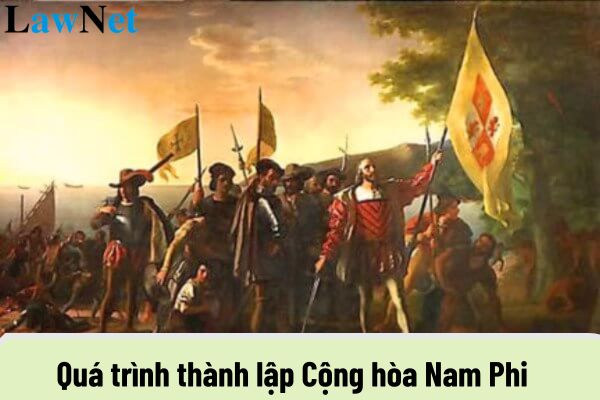How was the Republic of South Africa established? What is the current roadmap for implementing the new general education curriculum in Vietnam?
How was the Republic of South Africa established?
Below is the process of how the Republic of South Africa was established:
How was the Republic of South Africa established?
Before the 17th century, the territory of South Africa was inhabited only by people of African origin. Then the Dutch turned South Africa into a colony called Cape in 1662. By the 19th century, South Africa became a British colony. In 1910, the territories of South Africa and Cape merged to form the Union of South Africa. In 1961, this country declared its withdrawal from the British Commonwealth and proclaimed the establishment of the Republic of South Africa. It can be seen that to appear on the map and become the Republic of South Africa today, South Africa went through the following stages:
Period as a Dutch Colony:
In this period, South Africa was a new area initially explored by navigators who named the cape of the island Cape. This area gradually became inhabited by the Dutch. Frequent skirmishes over interests and land at the borders occurred in this region. The Dutch living in this area were exiled nobility and often purchased slaves for subjugation.
Period as a British Colony:
In 1795, the United Kingdom took control of the Cape of Good Hope to prevent it from falling into French hands. By 1803, it was returned to the Dutch, but immediately after the Dutch East India Company declared bankruptcy, the British annexed the Cape Colony in 1806. Border wars continued to occur here.
Around 1867 and 1886, diamonds and gold were discovered in the South African region, leading to an intense wave of immigration. The Boer people here had two wars with the British but were ultimately defeated, and South Africa became a British territory.
Period of the Union of South Africa
After many years of negotiations, the Union of South Africa was formed from the Cape and Natal colonies, the Orange Free State, and Transvaal. The Union of South Africa became a self-governing territory within the British Commonwealth.
Stage of Becoming a Republic
Over time, on May 31, 1961, the country became the Republic of South Africa through a referendum in which white voters decided on the matter.
Thus, the Republic of South Africa was formed and went through two major colonial periods under Dutch and British control, later gaining freedom from Britain. During the formation of the Republic of South Africa, the region frequently experienced severe racial discrimination and slavery, causing severe hardships for the indigenous people. Black individuals had to live under extremely harsh and discriminatory conditions under the apartheid policies (existing from 1948 to 1994).
*Note: The information is for reference only./.

How was the Republic of South Africa established? What is the current roadmap for implementing the new general education curriculum in Vietnam? (Image from the Internet)
What is the current roadmap for implementing the new general education curriculum in Vietnam?
Based on the provisions of Article 2 of Circular 32/2018/TT-BGDDT:
- From the academic year 2020-2021 for grade 1.
- From the academic year 2021-2022 for grades 2 and 6.
- From the academic year 2022-2023 for grades 3, 7, and 10.
- From the academic year 2023-2024 for grades 4, 8, and 11.
- From the academic year 2024-2025 for grades 5, 9, and 12.
What are the objectives of the new general education program in Vietnam?
According to Article 8 of the Education Law 2019, the objectives of the new general education program are as follows:
- The education program reflects educational objectives; stipulates standards of knowledge, skills, requirements to achieve regarding the qualities and competencies of learners; the scope and structure of educational content; methods and forms of organizing educational activities; and ways to assess educational outcomes for each course in each grade level, level of education, or for each course, module, field of study for each level of training.
- The education program must ensure scientific and practical aspects; inherit and integrate among educational levels and training levels; enable streaming and transition between training levels, fields of study, and forms of education in the national educational system to allow localities and educational institutions to actively implement appropriate educational plans; meet gender equality goals, and integration into international standards. The education program is the foundation to ensure comprehensive education quality.
- The standards of knowledge, skills, and requirements to achieve regarding the qualities and competencies of learners specified in the education program must be concretized into textbooks for general education; curricula and teaching materials for vocational and higher education. Textbooks, curricula, and teaching materials must meet the requirements of educational methods.
- The education program is organized according to academic years for preschool and general education; according to academic regimes or accumulative module or credit methods or combinations of credits and academic regimes for vocational and higher education.
Learning outcomes in courses or credits, modules that learners accumulate when pursuing an educational program are recognized to consider transition values for equivalent courses or credits, modules in another educational program when learners change majors, fields of study, transition to other forms of study or pursue higher educational levels or levels of training.
- The Minister of Education and Training and the Minister of Labor, War Invalids, and Social Affairs, within their functions and powers, regulate the execution of the education program and the recognition of transition values in training outcomes at higher education and vocational levels.

